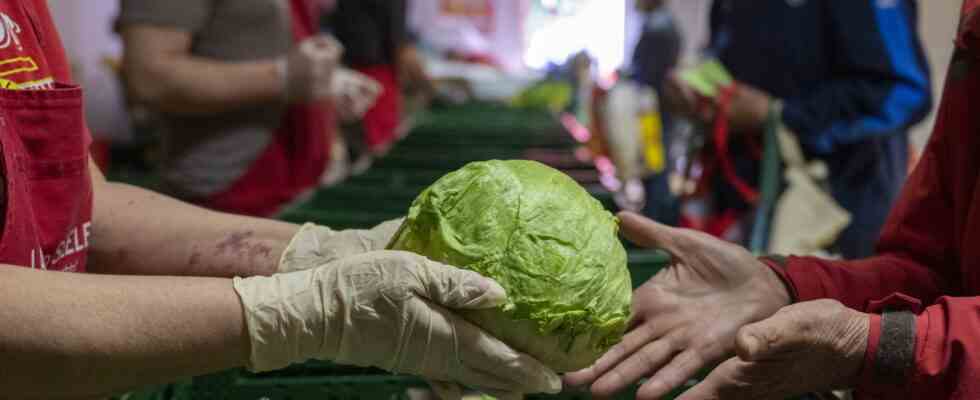Status: 07/14/2022 5:10 p.m
Two current statistics paint a bleak picture of the social situation in Germany: the food banks are currently providing for more people than ever before – and the Federal Office presented figures for the homeless for the first time, which are bitter.
The number of people who are listed as customers by the Tafel in Germany has increased significantly. Due to inflation, the pandemic and the consequences of the war, it has increased by about half since the beginning of the year, said Jochen Brühl, chairman of the German food bank. In the meantime, significantly more than two million people affected by poverty in Germany would use the offers such as free food. These are more recipients than ever before.
“The panels are at their limit and tell us that many people are coming to them who have just made ends meet and need help for the first time,” says Brühl. According to the information, every third board had to introduce a recording freeze. There was a lack of food or volunteers to help anyone who asked for support.
According to its own statements, the umbrella organization surveyed 962 member boards in June and July, and 603 boards took part in the survey. Virtually no Tafel recorded a decline in customers. About 60 percent stated that their clientele had increased by up to 50 percent since the beginning of the year. Almost a quarter put the increase at 50 to 100 percent. A good 16 percent even said that the number of their customers had doubled or more than doubled.
“End the watering can” of the relief packages
The Tafel collect surplus food from retailers and manufacturers and distribute it. According to the association, customers include many unemployed, low-income earners and pensioners – i.e. groups that are particularly hard hit by inflation.
The association chairman Brühl called on the federal government to urgently present a new aid package. The smallest part of the federal government’s relief package so far reaches people affected by poverty. Targeted emergency aid for poor people is now necessary, “No more watering cans,” said Brühl.
Refugees often sent to the Tafel
In the past few months, many refugees from the Ukraine have joined the Tafel’s traditional customer base. The Tafel-Verband also clearly criticized the authorities in this context. They would continue to refer refugees to the boards without consultation. Many people from Ukraine in particular had the wrong impression that the food banks were a state offer to which they were entitled.
600,000 more poor than before the pandemic
Experts and associations have recently pointed out again and again that the number of people in Germany who are affected by poverty is growing – also as a result of Corona and the resulting economic slump. According to the “Poverty Report” of the Paritätischer Wohlfahrtsverband, 13.8 million people in Germany, a country with 83 million inhabitants, now live below the – statistically defined – “poverty rate”. That’s about 600,000 more than before the pandemic.
“The findings are shocking, the economic effects of the pandemic are now having a full impact,” said the general manager of the welfare association, Ulrich Schneider, when the report was presented at the end of June. Poverty has never spread so rapidly in recent times as during the pandemic. In view of the currently high inflation rate, the association expects the situation to deteriorate further.
178,000 live in shelters
At the bottom end of the “poverty scale” are probably the people who don’t even have a roof over their heads. How many of them there are in Germany can only be estimated – because they have not yet been recorded statistically. However, the Federal Statistical Office has now presented data for at least a subgroup of them for the first time: for those who live in emergency and community accommodation or in temporary quarters. The office puts their number at 178,000. This roughly corresponds to the population of a large city such as Saarbrücken or Potsdam.
Almost two-thirds of those accommodated are men and a good third women. 37 percent are younger than 25 years, almost five percent are 65 years old or older. Families or single parents with children account for 46 percent of cases. According to the information, people were recorded who lived in rooms or overnight accommodation as of January 31, 2022, which were made available to them by municipalities or with reimbursement by other social service providers.
Homeless people staying with friends, families or acquaintances and homeless people living on the street were not recorded. Cases of refugees were only included if they had a positive asylum decision and were housed through the housing emergency assistance system.
“Better than previous estimates”
“The numbers that have now been published are an important step and better than previous estimates,” said Verena Göppert, deputy general manager of the German Association of Cities. According to the Federal Ministry of Social Affairs, it commissioned a representative study in order to be able to look at hidden forms of homelessness, such as staying with acquaintances and homelessness on the street. Figures should be available this fall.
There are already estimates. The Federal Working Group for Homeless Aid puts the number of homeless people in Germany at around 233,000.

